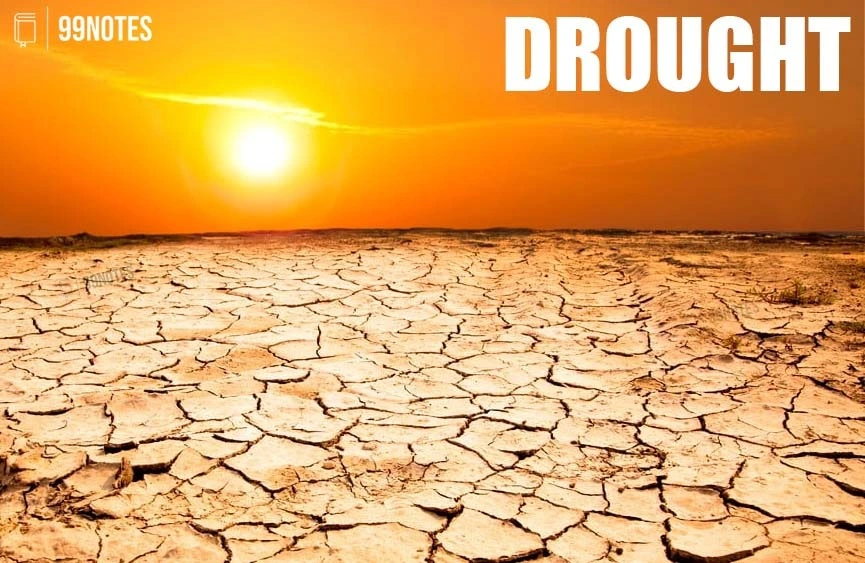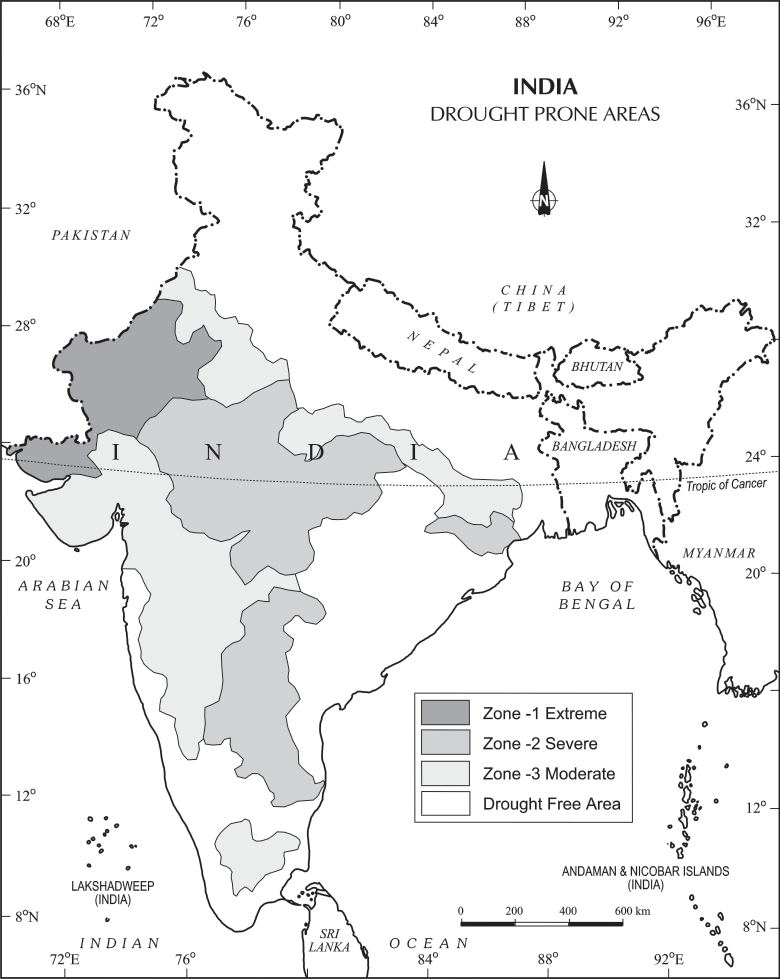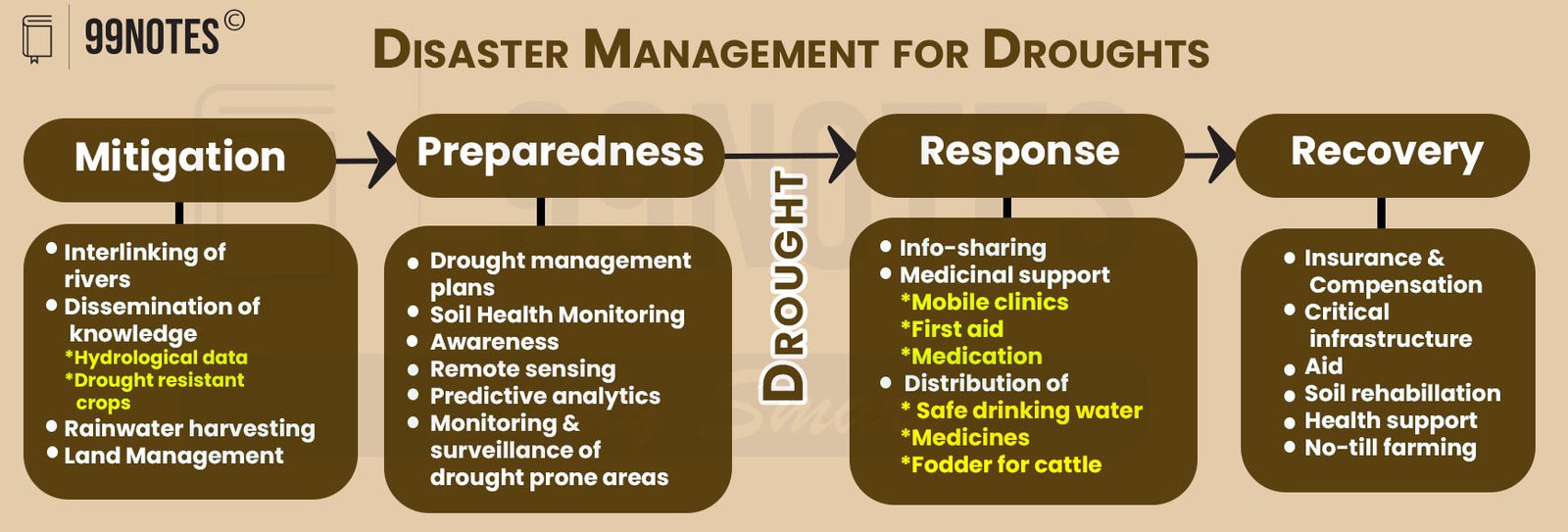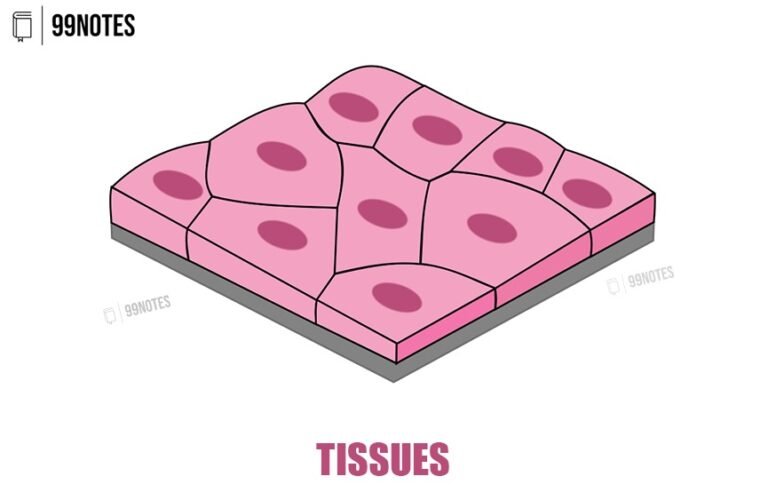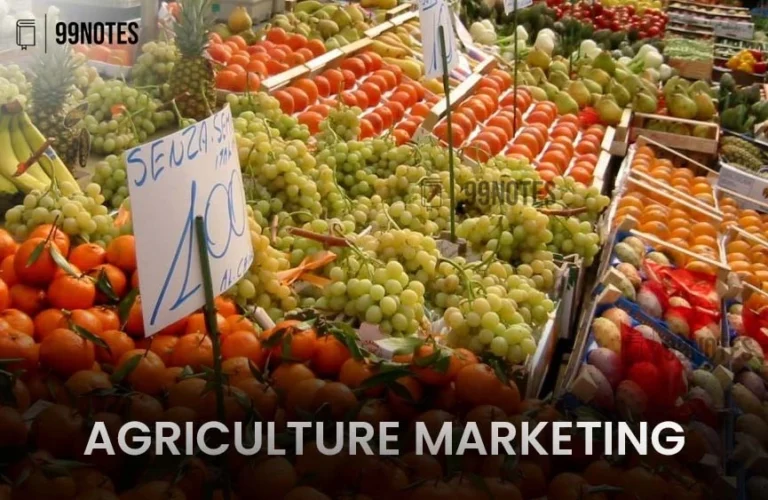Droughts
It is a complex phenomenon that involves elements of meteorology like precipitation, evaporation, evapotranspiration, groundwater, soil moisture, storage and surface run-off, agricultural practices, particularly the types of crops grown, socio-economic practices and ecological conditions.
Classification of Droughts
Droughts can be of various types:
- Meteorological Drought: when there is a prolonged period of inadequate rainfall marked with mal-distribution of the same over time and space.
IMD Definition: When rainfall deficiency is more than 10% and when 20-40% area of the country is under drought conditions, then the year is termed as an All India Drought Year. In 2016 IMD replaced the word drought to describe poor rainfall with “deficient year” & “large deficient year”. - Agricultural Drought: It is also known as soil moisture drought, characterised by low soil moisture that is necessary to support the crops, thereby resulting in crop failures. If an area has more than 30% of its gross cropped area under irrigation, the area is excluded from the drought-prone category.
- Hydrological Drought: when the availability of water in different storages and reservoirs like aquifers, lakes, reservoirs, etc. falls below what the precipitation can replenish.
- Ecological Drought: When the productivity of a natural ecosystem fails due to a shortage of water and as a consequence of ecological distress, damages are induced in the ecosystem.
The National Commission on Agriculture does not recognise Ecological drought.
| For example, the Latur (Marathwada) drought: It was a Meteorological drought since the Monsoon failed in 2015; This led to the failure of crops, becoming an Agricultural drought. By March 2016, all reservoirs dried up, creating a Hydrological drought.
The drought was so severe that the government had to bring a drought manual to deal with similar situations in the future. |
Drought Prone Areas in India:
According to some estimates, nearly 19% of the total geographical area of the country and 12% of its total population suffer due to drought every year.
About 30% of the country’s total area is identified as drought prone affecting around 50 million people. One region can suffer due to floods in one season and experience drought in the other – mainly because of the large-scale variations and unpredictability in the behaviour of the monsoon in India.
On the basis of the severity of droughts, India can be divided into the following regions:
- Extreme Drought Affected Areas: most parts of Rajasthan, particularly areas to the west of the Aravali hills, i.e. Marusthali and Kachchh regions of Gujarat fall in this category. Included here are also the districts like Jaisalmer and Barmer from the Indian desert that receive less than 90 mm average annual rainfall.
- Severe Drought Prone Area: Parts of eastern Rajasthan, most parts of MP, eastern parts of Maharashtra, interior parts of AP and Karnataka Plateau, northern parts of interior TN and southern parts of Jharkhand and interior Orissa are included in this category.
- Moderate Drought Affected Area: Northern parts of Rajasthan, Haryana, southern districts of UP, the remaining parts of Gujarat, Maharashtra except Konkan, Jharkhand and Coimbatore plateau of Tamil Nadu and interior Karnataka are included in this category. The remaining parts of India can be considered either free or less prone to drought.
Declaration of a drought in India:
Manual for Drought Management, 2016 released by M/o Agriculture & Farmers Welfare, prescribes “new scientific indices and parameters” for a “more accurate assessment of drought” in the country.
The manual lists five categories of indices, which include rainfall, agriculture, soil moisture, hydrology, and remote sensing (health of crops).
The State Governments declare drought through a notification specifying clearly:
- The geographical extent and administrative units such as Gram Panchayats, Blocks, Mandals, Taluks, Subdivision, and Districts.
- Such notification should also indicate the level of severity of the drought (moderate or severe).
Problem: Often States do not declare a condition as a drought despite visible drought-like conditions.
Consequence of Drought:
Droughts have both immediate as well as long-term disastrous consequences on the social and physical environments.
- Crop failure/Drop in yield: leading to scarcity of food grains (Akal), fodder (Trinkal), inadequate rainfall, resulting in a shortage of water (Jalkal), and often a shortage in all three (Trikal) is most devastating.
- Large-scale death of cattle and other animals,
- migration of humans and livestock.
- Diseases: Scarcity of water compels people to consume contaminated water resulting in the spread of many waterborne diseases like gastro-enteritis, cholera, hepatitis, etc.
- Social Impact: The burden of water collection also disproportionately falls on women (72%) and girls (9%) according to UNCCD’s Drought in Numbers, 2022.
Thus, it is clear that the biggest impact of any drought is on the Agricultural economy. For the mitigation of this impact Crop and livestock insurance is necessary. PMFBY is one such scheme working in this direction.
| Pradhan Mantri Fasal Bima Yojana (PMFBY) |
| The PMFBY aims to reduce the premium rates to be paid by the farmers so as to enable more farmers to avail insurance coverage against crop loss on account of natural calamities.
Farmers’ premium:
Advantages:
Criticism:
|
How to deal with Droughts?
Let’s organise our efforts to reduce the risk of drought into short-term measures (i.e. immediate response and preparedness) and long-term Measures (Mitigation measures).
Immediate Response:
In case of drought, the following immediate must consider two aspects:
- Provision for the distribution of safe drinking water, medicines for the victims and
- Availability of fodder and water for the cattle and shifting of the people and their livestock to safer places, open fodder camps.
- Water resources should not be used for recreational and other non-essential purposes in the year of deficient monsoon.
The drought manual released by the Department of Agriculture gives a stepwise comprehensive strategy for drought prevention and response.
Responsibility of the government
National Level:
- The Ministry of Agriculture and Farmers Welfare prepares a Crisis Management Plan (CMP) for drought before each Kharif season.
- The National Disaster Response Fund (NDRF) provides financial support for severe drought conditions.
- Establishment of Drought Monitoring Centres for real-time assessment and forecasting.
- IMD gives a forecast of rainfall and can predict drought-like situations.
State Level:
- States formulate Drought Mitigation Plans for vulnerable districts.
- Relief measures like agricultural input subsidies, tax waivers, and employment generation programs.
- Encouragement of community-based water management programs.
District Level:
- District administration implements Agriculture Contingency Plans for managing drought phases.
- Establishment of fodder banks and food security programs for affected populations.
- Water resource management through local reservoirs and water bodies.
Local Level (Panchayat & Village):
- Promotion of self-help groups and community participation in drought response.
- Monitoring of drinking water sources and provision of alternate supply arrangements.
- Capacity building and training of local farmers on adaptive agricultural practices
These coordinated efforts aim to build resilience against droughts and ensure sustainable water and agricultural practices.
| Did you Know? |
| United Nations Convention to Combat Desertification (UNCCD) is currently testing a drought toolbox that uses a total of 15 to 30 different parameters to assess drought risk and vulnerability of a geographical region. |
Long-term Mitigation Measures
The drought manual released by the Department of Agriculture gives a stepwise comprehensive strategy for drought mitigation too:
Prevention and Mitigation Measures at the technological level:
- Crop Diversification: Encourage the cultivation of drought-resistant crop varieties and adopt crop rotation to improve soil health and resilience.
- Afforestation: Promote tree planting and forest conservation to enhance soil moisture retention and reduce erosion.
- Soil Conservation: Apply techniques like contour ploughing and terracing to prevent soil degradation and maintain fertility.
- Efficient water-use policies like regulating irrigation and industrial water consumption.
- Strengthening public awareness campaigns on water conservation.
- Development of drought vulnerability and risk maps for targeted interventions.
- Encouragement of micro-irrigation techniques like drip and sprinkler irrigation.
- Promotion of alternative livelihoods for farmers in drought-prone areas.
- Enhancing climate change adaptation strategies in agriculture.
Mitigation Measures at the government level
Long term Planning and the following measures can be possible:
- Identification of groundwater potential in the form of aquifers and their preservation.
- Implementation of watershed management and groundwater recharge projects.
- Interlinking of rivers: transfer of river water from the surplus to the deficit areas, and particularly planning for construction of reservoirs and dams, etc.
- Remote sensing and satellite imageries can be useful in identifying the possible river basins that can be interlinked and in identifying the groundwater potential, excess and deficit areas.
- Dissemination of knowledge about
- Hydrological data
- Drought–resistant crops and proper training to practise the same.
- Rainwater harvesting can also be an effective method in minimising the effects of drought.
- Better reservoir management using better technologies like artificial intelligence.

